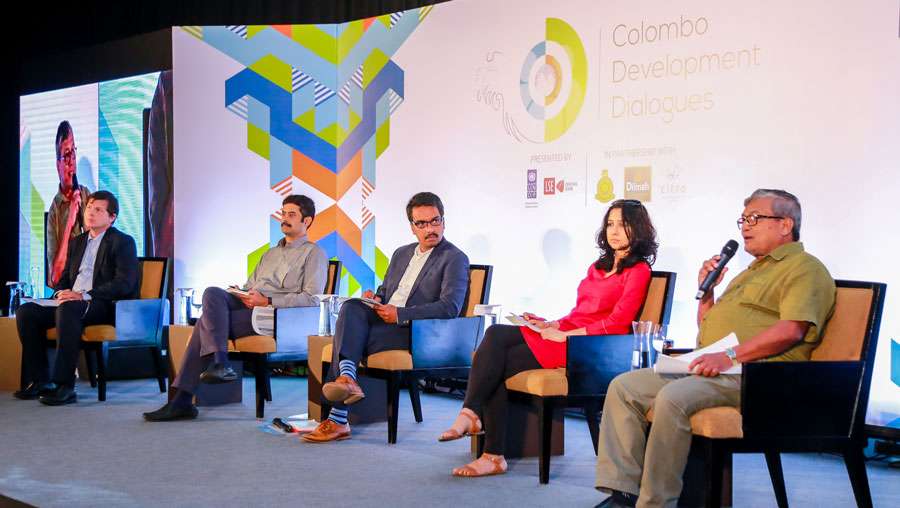04 Sep 2018 - {{hitsCtrl.values.hits}}

From left: Dr. Timotheues Gaasbeek, Dr. Giriraj Amarnath, Dr. Nilanjan Sarkar (Moderator), Dr. Soumya Balasubramanya and Dr. P.B Dharmasena
Pic by Damith Wickramasinghe
By Nishel Fernando
A leading academic recently proposed to set up a coordination body and to launch a comprehensive watershed management plan to manage Sri Lanka’s water resources effectively as the current uncoordinated intuitional framework poses risks to the country’s water security, despite having sufficient water resources.
“We are not managing the water resources well. We receive 2000-millimetres rainfall annually, amounting to about 131.22 billion cubic-metres of water. However, half of it goes to the sea,” University of Colombo, Agriculture and Water Management consultant and visiting Lecturer of University of Rajarata, Dr. P.B. Dharmasena said.
He was speaking at the latest ‘Colombo Development Dialogues,’ a collaborative initiative by the LSE South Asia Centre (LSE-SAC) and the United Nations Development Programme in Sri Lanka, in partnership with Dilmah Tea, Citra Social Innovation Lab, and the Faculty of Graduate Studies, last Friday in Colombo.
Dr. Dharmasena pointed out that there are over 10 ministries responsible for managing water resources linked to 28 State agencies, which has led to a lack of institutional coordination.
“We should have a coordination body, which is independent of politics, compromising national level, district level and divisional secretariat level committees. The decision making should be allowed both ways-from bottom to top and top to bottom,” he said.
Dr. Dharmasena emphasised that the ground level issues were only known to persons who operate at that level and hence they should be able to make decisions at divisional secretariat level while the macro level issues must be addressed through a national level body.
He also pointed out that due to the absence of a national water policy, Sri Lanka’s water resources are not managed effectively to address the agricultural, domestic, municipal and industrial water demands, which are growing at an accelerated rate.
Hence, Dr. Dharmasena proposed at least to formulate and implement a comprehensive watershed management plan in Sri Lanka.
“We want to go for a comprehensive watershed management plan and it should be operated on the basis of our ways and models that is sustainable in the long-term. It shouldn’t be a battle between drinking and agricultural water as both should be combined. In order to ensure water security, multiple water resources should be considered,” he opined.
Sri Lanka has 103 river basins, 80 major reservoirs and dams, 14,204 minor tanks and 12,942 minor anicuts.
However, Dr. Dharmasena pointed out that there are major disparities in terms of utilisation of water from the major river basins, as the country’s over 1,600 tank cascade system is mainly concentrated in North and East, North Central, North Western and Southern provinces.
He noted that Gin, Kalu and Kelani river basins, which flow to the Indian Ocean through the Western Province, have about 60 percent water drainage to the sea while water drainage of other river basins such as Malwatu Oya, Yan, Kala and Daduru Oya amount to less than 20 percent.
Dr. Dharmasena further highlighted that higher water drainage from large river basins such as Gin, Kalu and Kelani to the sea also causes floods, while other areas of the country suffer from drought due to mismanagement of these water resources.
“We can minimise the risk of floods and drought by managing the river basins well. If you can have reservoirs at the middle of river basins, that will solve the problem of droughts and floods,” he said.
Joining the discussion, an expert in international water resource management, specialist in water security and climate variability, Dr. Timotheus Gaasbeek commented on changing rainfall patterns in Sri Lanka and its implications on how Sri Lanka could utilise the water resources available in the country.
He said Sri Lanka is in a wet season and would soon enter into a dry season and stressed that country’s water management policy should be adopted to face the upcoming dry season as most of Sri Lanka’s reserves were built during 1970’s, which was wet season.
Dr. Gaasbeek also touched upon the changes of rainfall in certain areas of Sri Lanka, which might be due to land use.
“During the southwest monsoon, water that usually falls in Nuwara Eliya falls in Colombo. I have a hunch that this is due to changes in land use over the last 100 years,” he said.
Meanwhile, a senior researcher on environment and development economics, Dr. Soumya Balasubramanya stressed that the water security initiative should be more inclusive, particularly strengthening the capacities of rural women who face the brunt of challenges arising from climate change.
She pointed out that 33 percent of female workforce in Sri Lanka is employed in agriculture while 40 to 50 percent of agriculture workforce is female. Hence she urged that a gender-based approach is needed to address the water security matter.
Meanwhile, a research group leader for water risks and disasters, Dr. Giriraj Amarnath emphasised that Sri Lanka needs to move towards climate smart agriculture in order to address climate variability and water security.
Commenting on how to mitigate contamination of water, the panellists agreed that stronger regulations are needed to control contamination of water with the involvement of all stakeholders.
“Some regulations are needed to control the contamination of water, as even though we have some acts such as Agrarian Services Act, it doesn’t work. Hence, we should formulate implementable policies,” Dr. Dharmasena said.
The United Nations Development Programme (UNDP) also plans to develop a working paper from the recently concluded dialogue on water security.
17 Nov 2024 2 hours ago
17 Nov 2024 2 hours ago
17 Nov 2024 2 hours ago
17 Nov 2024 4 hours ago
17 Nov 2024 4 hours ago